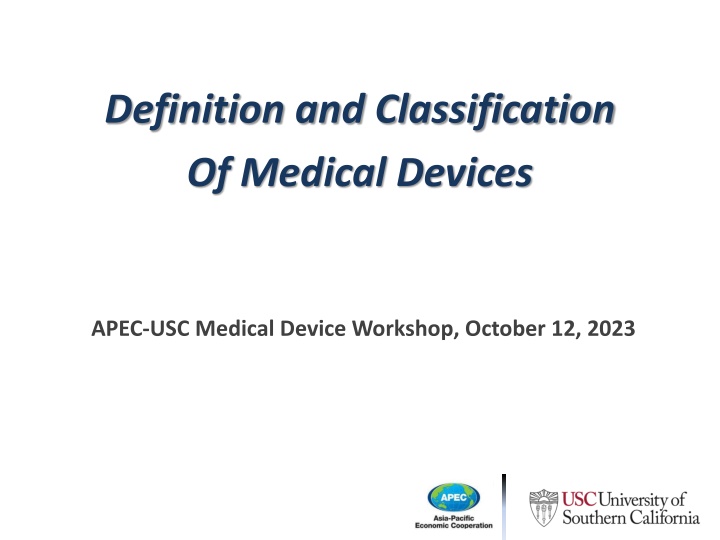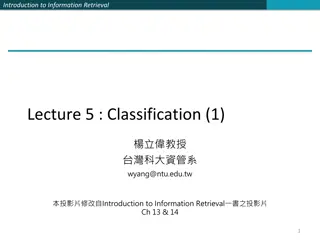
Medical Device Classification and Global Harmonization Efforts
Explore the intricacies of medical device classification, the challenges of regulatory harmonization, and the impact of globalization on industry standards. Learn about the unique regulations in different countries and the divergent considerations for advanced therapies in Japan, the US, and the EU.
Download Presentation

Please find below an Image/Link to download the presentation.
The content on the website is provided AS IS for your information and personal use only. It may not be sold, licensed, or shared on other websites without obtaining consent from the author. If you encounter any issues during the download, it is possible that the publisher has removed the file from their server.
You are allowed to download the files provided on this website for personal or commercial use, subject to the condition that they are used lawfully. All files are the property of their respective owners.
The content on the website is provided AS IS for your information and personal use only. It may not be sold, licensed, or shared on other websites without obtaining consent from the author.
E N D
Presentation Transcript
Definition and Classification Of Medical Devices APEC-USC Medical Device Workshop, October 12, 2023
Some efforts to address harmonization Development of harmonized technical standards Development of harmonized submissions and data standards Integrated approaches to inspections Regulatory inspections Industry initiatives International educational and confidence building opportunities
Globalization of industry reveals regulatory and quality dissonance Regulatory dissonance can: Increase costs Handicap development in less sophisticated societies Create non-tariff trade barriers FDA EMA PMDA
Every country has unique rules International Standards
In the US As defined by the FD&C Act, a device is: An instrument, apparatus, implement, machine, contrivance, implant, in vitro reagent or other similar or related article, including any component, part, or accessory, which is (a) recognized in the official national formulary, or US Pharmacopeia, or any supplement to them; (b) intended for use in the diagnosis, treatment or prevention of disease, in man or other animals; or (c) intended to affect the structure or function of the body of man or other animals, and which does not achieve its primary intended purposes through chemical action within or on the body of man or other animals and which is not dependent upon being metabolized for the achievement of its primary intended purposes
But detailed considerations differ Japan: Regenerative medicines Products US: medical devices subclassed as regenerative medicine advanced therapy (RMAT) EU: Advanced Therapy Medicinal Product.
Principles of Device Classification RAs should establish a device classification system consisting of four classes where Class A represents the lowest hazard and Class D the highest. The determination of class should be based on rules derived from the potential of a medical device to cause harm to a patient or user (i.e. the hazard it presents) and thereby on its intended use and the technology/ies it utilises. Is this a problem?
According to the standard, CLASS LEVEL DEVICE EXAMPLES A Low Hazard Bandages / tongue depressors B Low-moderate Hazard Hypodermic Needles / suction equipment C Moderate-high Hazard Lung ventilator / bone fixation plate D High Hazard Heart valves / implantable defibrillator
Classifications systems are legacy- vary remarkably US : Japan: Canada: EU: China: Vietnam: 4 classes Thailand: 3 classes Chile: 4 classes 3 classes 4 classes 4 classes 4 classes 3 classes I, II, III I, II, III,IV I, II,III,IV I IIa, IIb, III I, II, III A,B,C,D III, II, I I, II,III,IV
Shoulder prosthesis: Class III in Canada Class II in US Class III in Japan Scalpel: Class II in Canada Class I in the US Class I in Japan
For combination products If the combination results in a product that is intended by the manufacturer to meet a purpose different from that of the individual medical devices that make it up, the combination is a new medical device in its own right and should be classified according to the new intended use. If the combination is for the convenience of the user but does not change the intended uses of the individual medical devices that make it up (e.g. a customised kit that provides all the devices necessary to carry out a particular surgical procedure), the classification allocated to the assemblage for the purpose of a Declaration of Conformity is at the level of the highest classified device included within it.






















